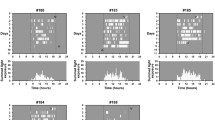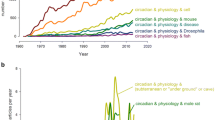Summary
-
1
Phase response curves for 15′ bright light pulses of four species of nocturnal rodents are described. All show delay phase shifts early in the subjective night, advance shifts in the late subjective night, and relative insensitivity during the subjective day.
-
2
The broad scatter in measured phase-shifts is largely due to error of measurement: the response of the pacemakers to light stimuli is more accurate than we observe.
-
3.
Indications are found that the response to a resetting stimulus at a given phase of the rhythm is correlated with the individual\(\bar \tau \) (freerunning period). Fast pacemakers (short\(\bar \tau \)) tend to be more delayed or less advanced by the light than slow pacemakers (long\(\bar \tau \)).
-
4.
Within individual mice (Mus musculus) the circadian pacemaker adjusts its resetting response to variations in its frequency: when τ is long (induced as after-effect of prior light treatment) light pulses at a defined phase of the oscillation (ct 15) produce smaller delay phase shifts than when τ is short.
-
5.
Among species there are conspicuous differences in the shape of the phase response curve: where\(\bar \tau \) is long, advance phase shifts are large and delay phase shifts small (Mesocricetus auratus); where\(\bar \tau \) is short, advance shifts are small, and delay shifts are large (Mus musculus;Peromyscus maniculatus).
-
6.
The functional meaning of the interrelationships of τ and PRC is briefly discussed.
Similar content being viewed by others
References
Burchard, J.E.: Resetting a biological clock. Ph. D. Thesis Princeton University, 1–66 (1958)
Christianson, R., Sweeney, B. M.: The dependence of the phase response curve for the luminescence rhythm inGonyaulax on the irradiance in constant conditions. Int. J. Chronobiol.1, 95–100 (1973)
Daan, S., Pittendrigh, C. S.: A functional analysis of circadian pacemakers in nocturnal rodents. III. Heavy water and constant light: homeostasis of frequency? J. comp. Physiol.106, 267–290 (1976)
DeCoursey, P.J.: Daily light sensitivity rhythm in a rodent. Science131, 33–35 (1960)
DeCoursey, P.J.: Effect of light on the circadian activity rhythm of the flying squirrel,Glaucomys volans. Z. vergl. Physiol.44, 331–354 (1961)
DeCoursey, P.J.: Function of a light response rhythm in hamsters. J. cell. comp. Physiol.63, 189–196 (1964)
Dowse, H. B., Palmer, J. D.: The chronomutagenic effect of deuterium oxide on the period and entrainment of a biological rhythm. Biol. Bull.143, 513–524 (1972)
Elliott, J.A.: Photoperiodic regulation of testis function in the golden hamster: relation to the circadian system. Ph. D. Thesis, University of Texas, Austin 248pp. (1974)
Kramm, K. R.: Circadian activity in the antelope ground squirrel,Ammospermophilus leucurus, Ph. D. thesis, U.C. Irvine, i–xviii, 267 pp. (1971)
Lohmann, M.: Der durch circadiane Frequenzänderung entstehende Fehler bei der Bestimmung von Phasenverschiebungen. Experientia (Basel)22, 340 (1966)
Natalini, J.J.: Relationship of the Phase-Response-Curve for Light to the Free-running Period of the Kangaroo RatDipodomys merriami. Physiol. Zool.45, 153–166 (1972)
Pittendrigh, C. S.: The circadian oscillation inDrosophila pseudoobscura pupae: A model for the photoperiodic clock. Z. Pflanzenphysiol.54, 275–307 (1966)
Pittendrigh, C. S.: Circadian systems. I. The driving oscillation and its assay inDrosophila pseudoobscura. Proc. nat Acad. Sci. (Wash.)58, 1762–1767 (1967)
Pittendrigh, C.S.: Circadian oscillations in cells and the circadian organization of multicellular systems. In: The neurosciences: Third Study Program (eds. F.O. Schmitt, F.G. Worden) pp. 437–458 Cambridge, Mass.: MIT Press 1974
Pittendrigh, C.S., Bruce, V., Kaus, P.: On the significance of transients in daily rhythms. Proc. nat. Acad. Sci. (Wash.)44, 965–973 (1958)
Pittendrigh, C. S., Daan, S.: A functional analysis of circadian pacemakers in nocturnal rodents. I. The stability and lability of spontaneous frequency. J. comp. Physiol.106, 223–252 (1976a)
Pittendrigh, C.S., Daan, S.: A functional analysis of circadian pacemakers in nocturnal rodents: IV. Entrainment: pacemaker as clock. J. comp. Physiol.106, 291–331 (1976b)
Pittendrigh, C. S., Minis, D. H.: The entrainment of circadian oscillations by light and their role as photoperiodic clocks. Amer. Naturalist98, 261–294 (1964)
Suter, R.B., Rawson, K.S.: Circadian activity rhythm of the deermouse Peromyscus: effect of deuterium oxide. Science160, 1011–1014 (1968)
Author information
Authors and Affiliations
Rights and permissions
About this article
Cite this article
Daan, S., Pittendrigh, C.S. A Functional analysis of circadian pacemakers in nocturnal rodents. J. Comp. Physiol. 106, 253–266 (1976). https://doi.org/10.1007/BF01417857
Received:
Issue Date:
DOI: https://doi.org/10.1007/BF01417857




